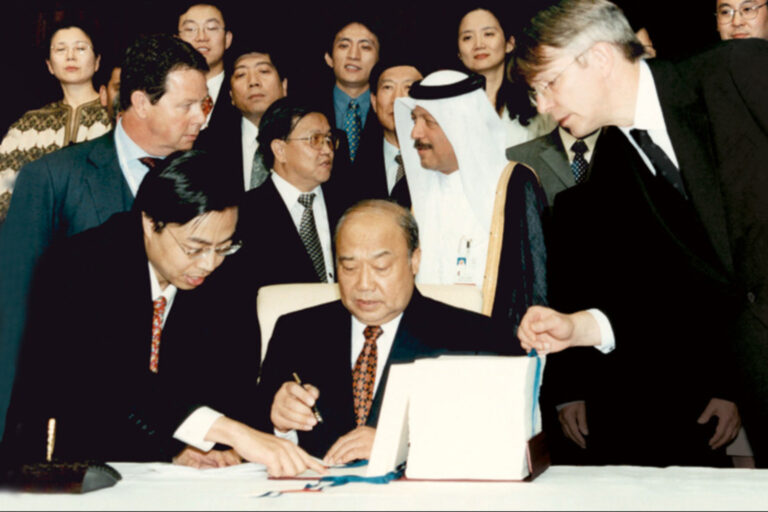Photo Credit: Deeba Yavrom
Note: The following piece is part of the SAIS Review‘s first web series on the topic of Sustainable Development and the Millennium Development Goals. For more information, please refer to the Sustainable Development web series page.
By Deeba Yavrom
GOAL: Create a more sustainable financial system, with universal access to basic banking.
TARGET: By 2030, set a plan to measure the sustainability of the financial system in various countries, to promote financial inclusion to the world’s poor, and to promote green banking policies in the world’s central banks.
Summary
Financial markets have, for a long time, been self-serving and myopic in their investment approach. The twenty-first century is an age where the financial industry is not only deeply integrated in the web of society, but has failed to provide the variable benefits needed to ensure long term and sustainable growth for both developed and developing countries. By enacting a system where the banking sector is required to implement sustainable banking principles, creating a blacklist that restricts market access to “dirty” polluting companies, and incorporating financial inclusion improvements for the world’s poorest, the flow of financial goods may at last be used in a green, healthier, and more sustainable fashion. According to the United Nations Environment Program (UNEP), a working definition of a sustainable financial system is one that “is aligned to the long-term health of the real economy, one that is green and inclusive,” and a sustainable banking goal would endeavor to achieve such a system.[1]
Background
The flaws of the financial system are easy to understand. There is a collective ideology that is focused on short-term growth, where profits are to be made at whatever the cost. Long-term sustainability is not even on the radar for the current financial system where a push to a greener and more sustainable financial future is critical. To begin the discussion it is important to define key terms to best understand the task at hand.
The UNEP Finance Initiative promotes an interesting paradigm shift into the allocation of innovative financial experiments worldwide. UNEP’s “let one thousand flowers bloom” mantra promotes the idea that creative financial structures are still in their infancy, and—since each structure can have an unknown potential—they should not yet be hindered by excessive regulatory mechanisms. With that in mind, there have been many attempts to restructure various financial segments to enable better facilitation into a green economy. A few examples are presented below:
The Nigerian Central Bank has implemented its Nigerian Sustainable Banking Principles program, which serves to guide eligible banks to align their conduct so as to improve their environmental and social performance.[2] Applying this approach to all segments of the financial sector, each bank must adhere its practices and policies to comply with all local laws, proposed best practices of the International Finance Corporation (IFC), and the World Bank’s Environmental, Health, and Safety regulations. Indonesia, too, has had notable exposure as one of the leaders of action against climate change among developing countries, and their banking policies follow the same sentiments.[3] By adopting a green banking policy, the financial sector aims to address compliance and due diligence towards financing renewable energy, energy efficiency projects, sustainable agriculture, green buildings, eco-tourism, and environmental protection.
Sometimes the worst emitters have the most innovative financial policies. China, one of the leading global contributors to carbon emissions also carries with it a few clever and effective policies to help curb its carbon dioxide (CO2) emissions. Through a variety of “green” mechanisms, China has developed a powerful blacklist of companies deemed “dirty” as high polluters to the environment. Companies who find themselves on the blacklist have a much harder time accessing affordable loans and gaining entry into capital markets via IPO offerings, and also face higher insurance and liability rates, which are in turn meant discourage them from environmentally risky projects.[4]
Although there have been significant advances towards the development of a sustainable financial future, there are still many challenges that lay ahead. One of the biggest obstacles is the financial sector itself, which holds a strong reluctance in seeing money being divested away from low-risk, high-reward short-term investments to higher-risk, lower-reward and longer-term investments. The status quo of the financial system has been uprooted since the financial crisis of 2008 and a shift into green investment is all but necessary to have a healthy financial sector. But to claim that green investments are high-risk and low-reward is a misnomer. For insurance companies especially, the trend is shifting away from risk transfer to risk control. That is, it is more profitable for an insurance company to mitigate the total risk of an investment than to dole out high rate insurance policies for risky situations.[5] Given the prevalence of climate change in today’s world, a balanced long-term model is preferable to the ever-elusive high-risk, high-reward model.
Additionally, investment banks may find it difficult to adjust portfolio preferences to cleaner and greener investments. This is a trend that is soon becoming antiquated. A byproduct of the Copenhagen Conference in 2007, the Green Transition Scoreboard (GTS) has been tracking total country private investment into the green sector. Under the assumption that all economies have to eventually move to a more sustainable and less polluting infrastructure, the GTS value has quintupled since 2007, from a meager US$1.2 trillion to a modest $5.7 trillion of total dollars that are invested into the green economy.[6] This implies two things: that more and more financial institutions are seeing green investment as great diversification additives to portfolios, and that there is a fast and steady growth in green infrastructure. A second signal showing positive growth in green investments is the “Finding Ethical alpha” Group, comprised of two hundred private equity investors and asset managers that all have fossil fuel free investment portfolios. This is a program that tries to retrain investment managers that enjoy seeing the benefits of clean investments.
To carry the thinking further, oil producers argue that their resource extractive investments are just too good to divert away from but have yet to realize that these dirty “brown” investments cannot be held to the same return rates in the long-term. “Shared value,” a concept introduced by Michael Porter and Mark Kramer of the Harvard Business School, claims that the economic competitiveness of a company is dependent on—and goes hand in hand with—the overall health of the community it is a member of.[7] Considered a new concept in business development, the argument states that a company should seek to improve its community to see better economic growth and long-term stability. There are three opportunities that arise once the idea of shared values is implemented. First is via local supplier development, in that a company that works with its surroundings can expect growth in its network infrastructure. Second, productivity and efficiency will increase while community economic development will grow. Lastly, companies can serve their markets better, which can lead to new product innovation and lower costs.
Opportunity
Finance has an interesting role to play in the general scheme of United Nations (UN) development goals. Most, if not all, of the UN development goals require some sort of financial contribution to see success. With a 2012–2013 budget of USD$5.5 billion, the success of these development goals is in large part dependent on the financial contributions made to them. Utilizing a top-to-bottom approach can potentially change the entire financial structure to better fit the UN development goals.
Currently, the largest economies in the world decided to commit $100 billion to institutional financial investment by December 2015. According to UNEP, investing two percent of global GDP into ten key sectors could kick-start a global transition towards a low carbon, resource efficient green economy.[8] This amount is either 2 percent of gross domestic product (GDP) or $100 billion in financial investment (2 percent of gross world product sits at $168 billion). But how can this money be mobilized? Currently, a research project being undertaken by Johns Hopkins University’s School of Advanced International Studies (SAIS) is looking at total global subsidies to the financial sector. This project may prove vital in understanding the relative value of $100 billion. The financial system is widely accepted as the most subsidized sector of most economies, as it often obtains competitive advantages that negate the efficiency of free markets. Therefore, if the financial system is being subsidized by an amount much greater than the $100 billion of necessary commitments, then the necessary readjustments can be achieved by diverting money away from a bloated financial sector and into a more sustainable one.
The need for an increased rate of financial inclusion is one of the key determinants of the success of a sustainable financial sector. Currently, over 2.5 billion people remain without access to financial services. Micro-lending institutions have been intact since the 1970s, but the model of small capital loans at interest rates of 30 percent and higher are being phased out as there is new data confirming the widely held belief in western countries that financing an investment through accumulated savings is much more sustainable. In developed countries, leveraging even a small fraction of assets to take out a loan at a 30 percent interest rate would prove to be financially irresponsible, and in poor countries where sensitivities to risk are much higher, high interest rate loans that were once considered as exploitative debilitates an investor from paying back his or her debt. To help remedy this, the rich and the poor need access to banks and basic financial services to effectively plan ahead for big expenses. In an age where the concept of a brick and mortar bank can be replaced by a cellphone and a mobile app, this seemingly simple step would provide a great leap forward for the poorest 2.5 billion of the world.
Goal and Target
Many have experienced the ill effects of the global recession, and consequently the prioritization of Sustainable Development Goal 11(g), “to promote sustainable consumption and production patterns—through a sustainable financial system” must be stressed. Appropriately broad in its approach, emphasis should be made to narrow the focus and set a target that by 2030 there will be, at the very least, potential access to financial services for all of the world’s populations. By “potential access” it is meant that each and every person will have the ability to either walk into a bank in his or her local municipalities, or purchase a phone that is supported by local banking infrastructure. In addition, an aim to seek by 2030, that all of the world’s central banks will incorporate sustainable development principles in their business practices. As the influence of the central bank permeates into regular society, the goal is to see the effects and advantages of the green economy trickle down to the private sector.
This is a global undertaking and the responsibility to carry out the tasks will fall on many. The foremost authority to enact these measures will fall upon the central bank and an associated committee created by the UN to oversee sustainable policy implementation. The financial banking inclusion aspect proves to be more difficult and, therefore, a more strategic approach is needed. To implement this, a sub-committee should be formed, representing key players in the premier financial sectors: micro-lending, private equity, central banks, and investment banks. This sub-committee should be asked the following: 1) To devise an action plan to increase financial inclusion in the world; 2) To find key obstacles in each of the world’s weakest performing countries; and 3) To develop a framework and action plan for each of these countries that can then be sent to the respective ministers of finance to then incorporate in their government proceedings.
As with any goal, the degree of measurement is just as important as the goal itself. Therefore, adopting the GTS platform as a metric to see which countries are accepting banking sustainability standards would reduce the information gap. To determine financial inclusion, no new metric is needed besides those currently in place, which use total customer rates relative to total population—focusing more on total savings rate relative to income—to see how the banks are being used, but this is more of a refinement than a new action.
The destructive nature of the current financial system does not allow for the implementation of a variety of development goals because its antiquated thinking restricts more sustainable revisions. Implementing a wide array of targets to see a more sustainable system can empower the world’s poor to gain access to capital markets, find opportunities in clean investments, foster a sense of collaboration between the world’s countries, and create a greener and cleaner world. The financial crisis has highlighted the hard way the necessity for stability; now is not the time to make the same mistake with sustainability.
Deeba Yavrom is a MA candidate at the Johns Hopkins Paul H. Nitze School of Advanced International Studies.
Citations
[1] Simon Zadek and Nick Robins, “Aligning the Financial System with Sustainable Development.” Inquiry: Design of a Sustainable Financial System, United Nations Environment Programme, 2 (2014).
[2] Awoyungbo Sola, “Implementation of Sustainable Banking Principles by Banks, Discount Houses and Development Finance Institutions in Nigeria,” Central Bank of Nigeria: 1-15, http://www.cenbank.org/out/2012/ccd/circular-nsbp.pdf.
[3] Edi Setijawan, “Role of Bank of Indonesia to support Green Investment,” Lecture, from Central Bank of Indonesia,
[4] Yunewb Bai, Michael Faure, and Jing Liu, The Role of China’s Banking Sector in Providing Green Finance,
[5] Francies Weyzig, Barbara Kuepper, Jan Willelm Van Gelder, and Rens Van Tilburg, “The Price of Doing Too Little Too Late,” Green New Deal Series, 11, http://gef.eu/uploads/media/The_Price_of_Doing_Too_Little_Too_Late_.pdf.
[6] Hazel Henderson, “All About the Green Transition Scoreboard,” http://www.ethicalmarkets.com/category/green-transition-scoreboard/.
[7] Michael Porter and Mark Kramer, “Creating Shared Value.” Harvard Business Review, 2011. https://hbr.org/2011/01/the-big-idea-creating-shared-value.
[8] United Nations Environment Programme, “Green Economy: Pathways to Sustainable Development and Poverty Eradication,” 2011, http://www.unep.org/greeneconomy/Portals/88/documents/ger/ger_final_dec_2011/Green EconomyReport_Final_Dec2011.pdf.



